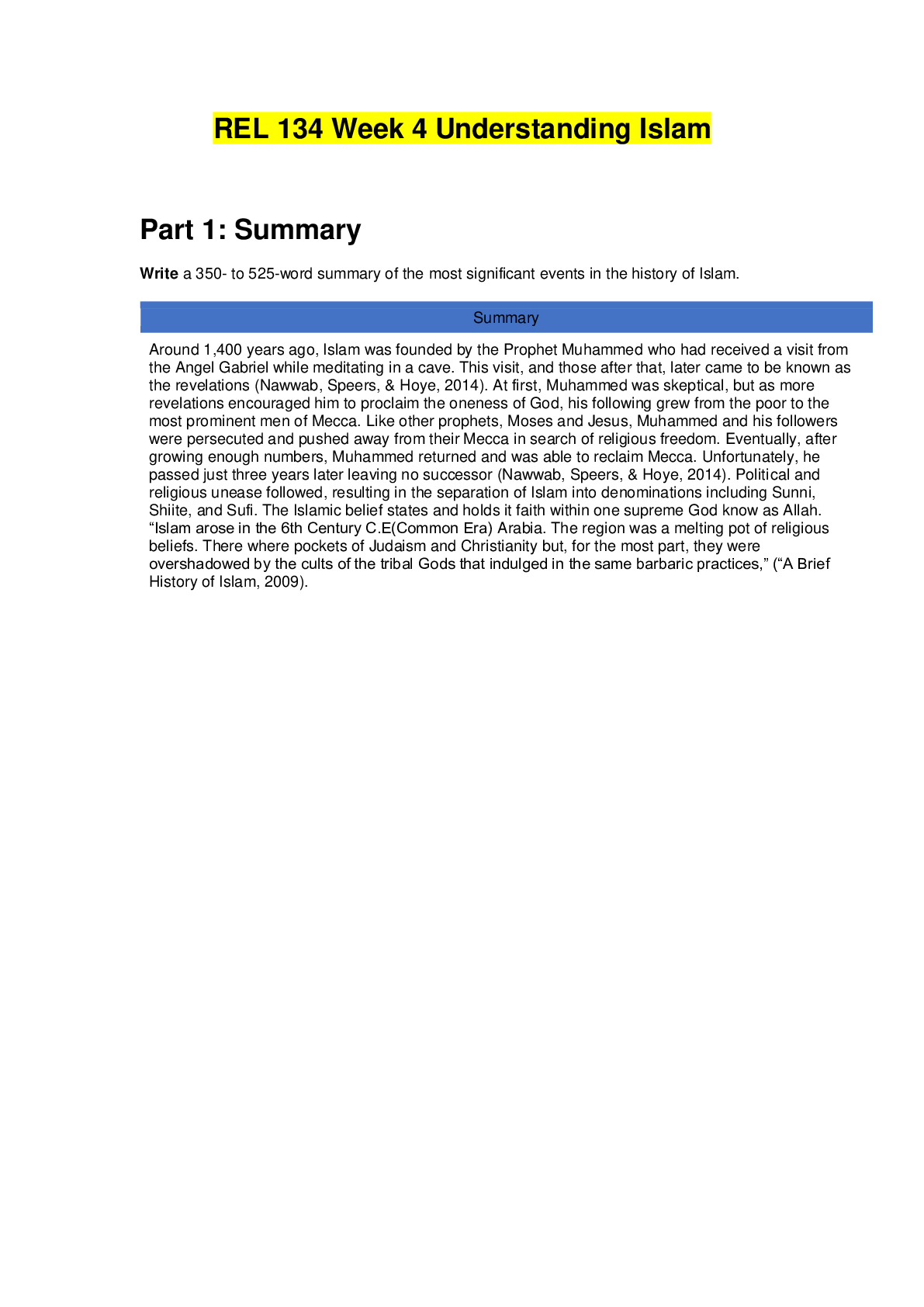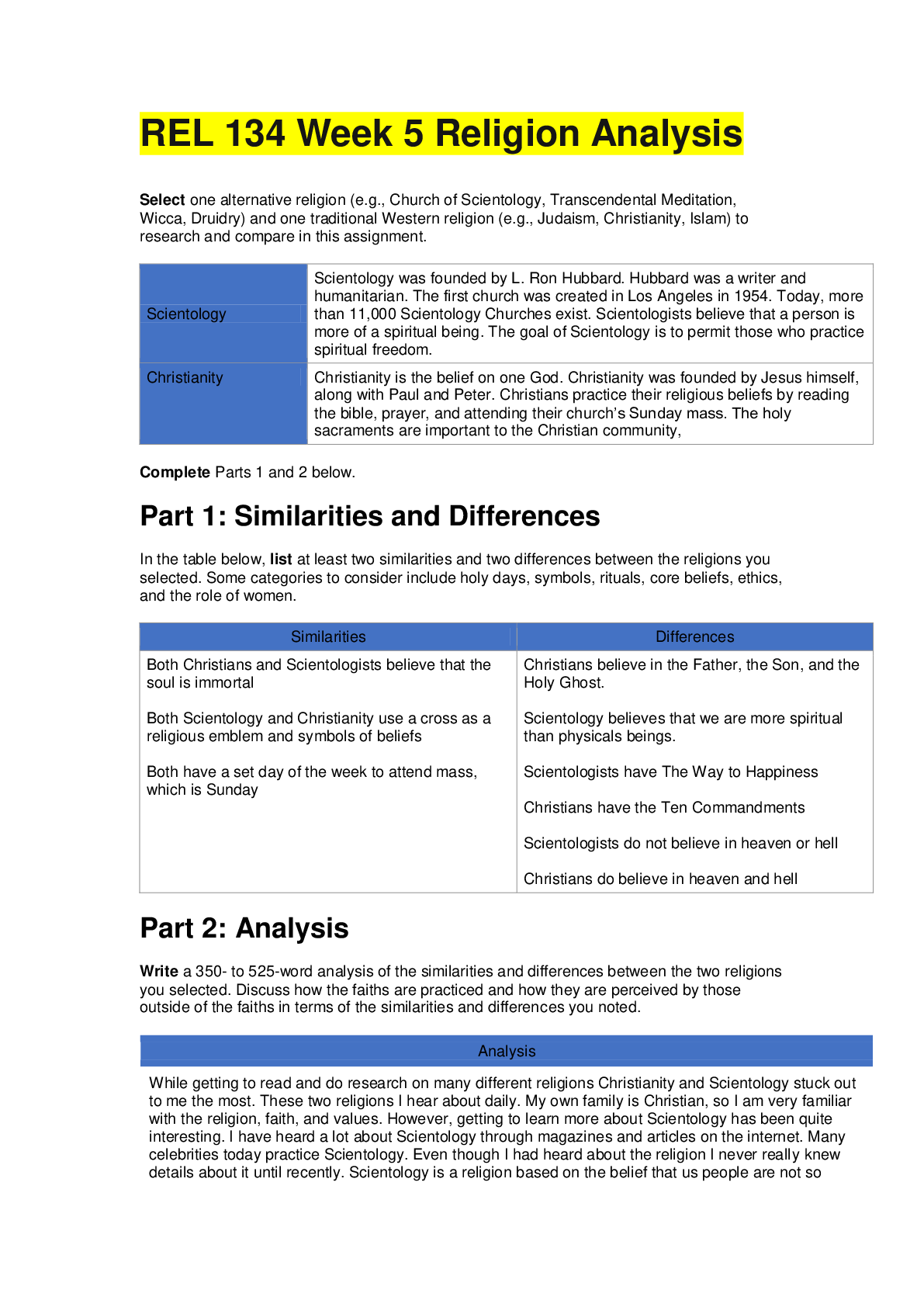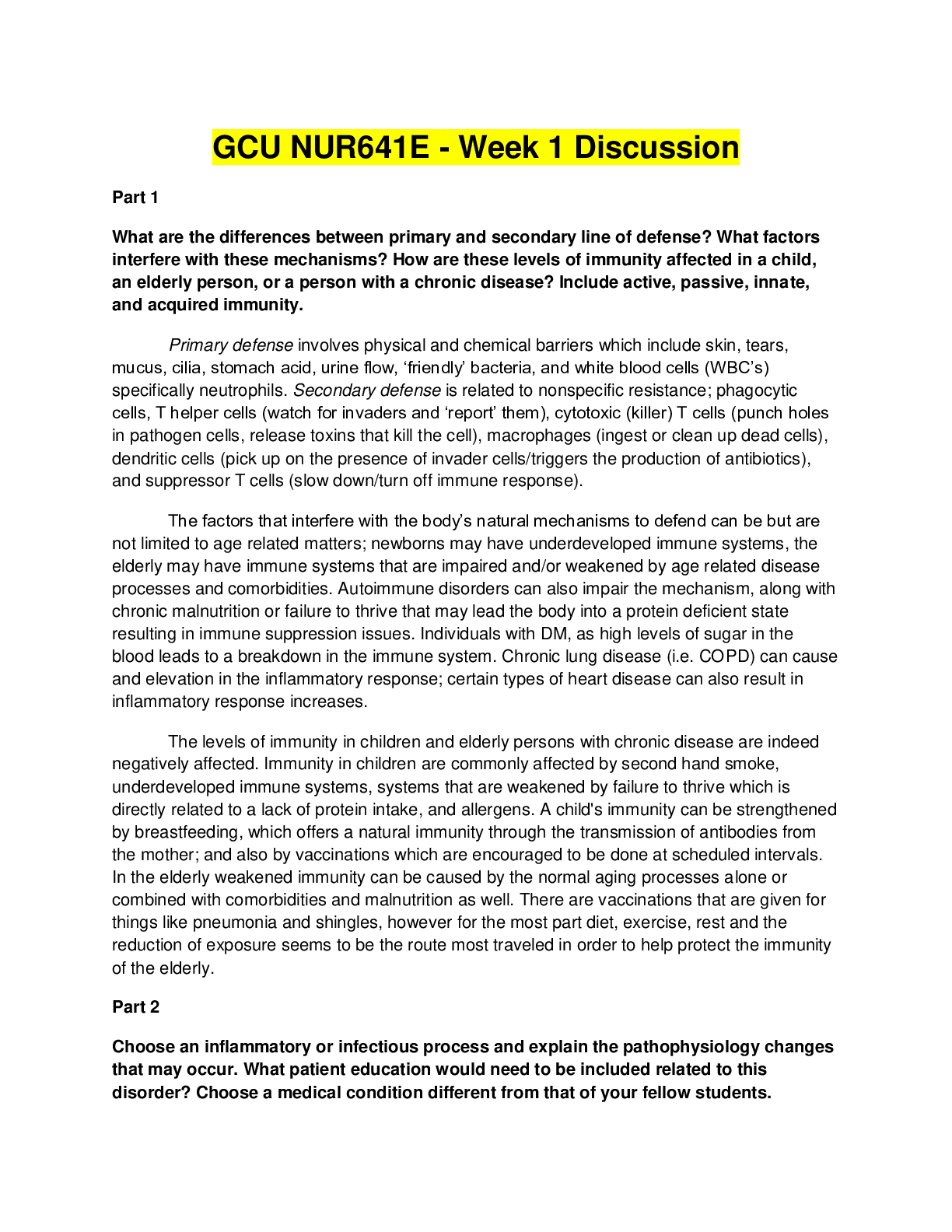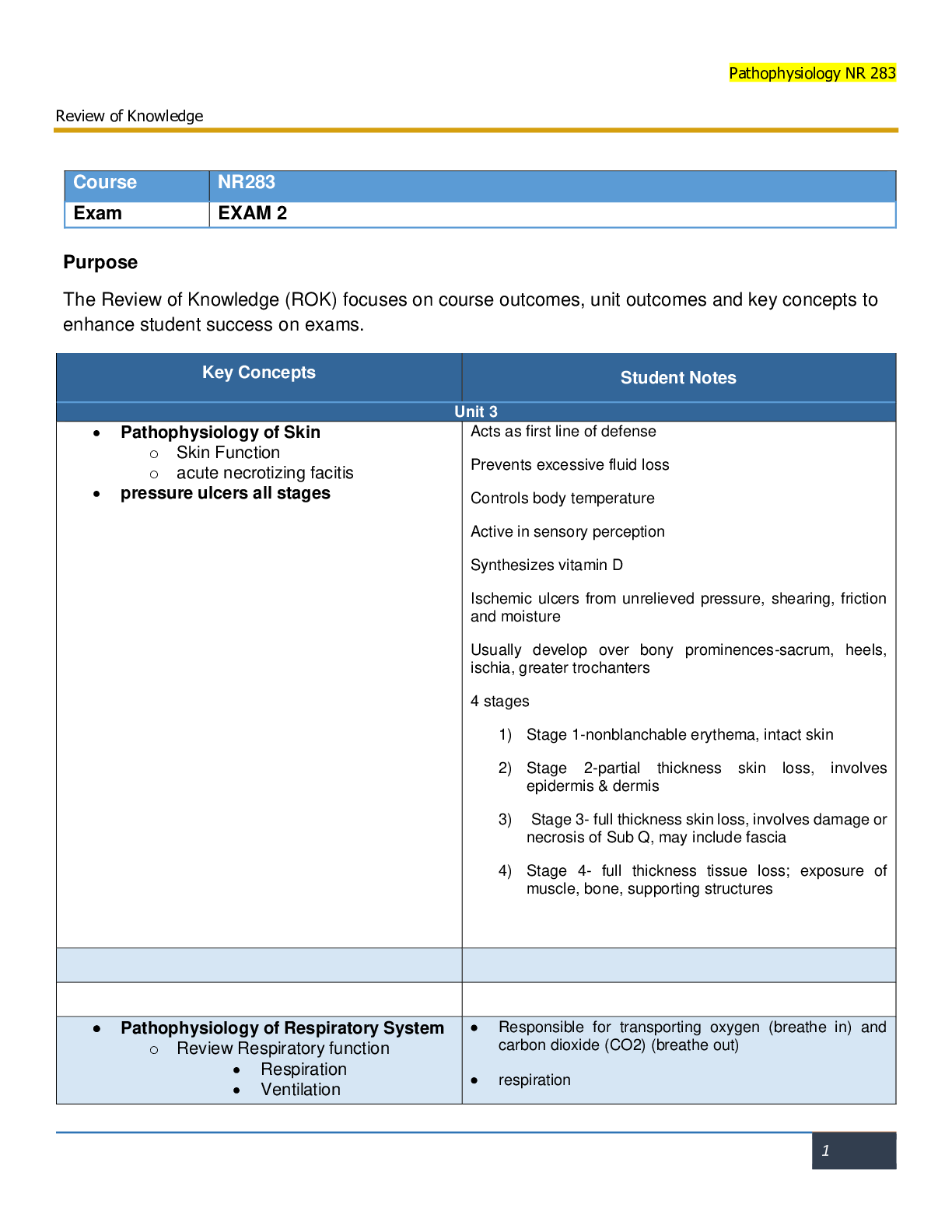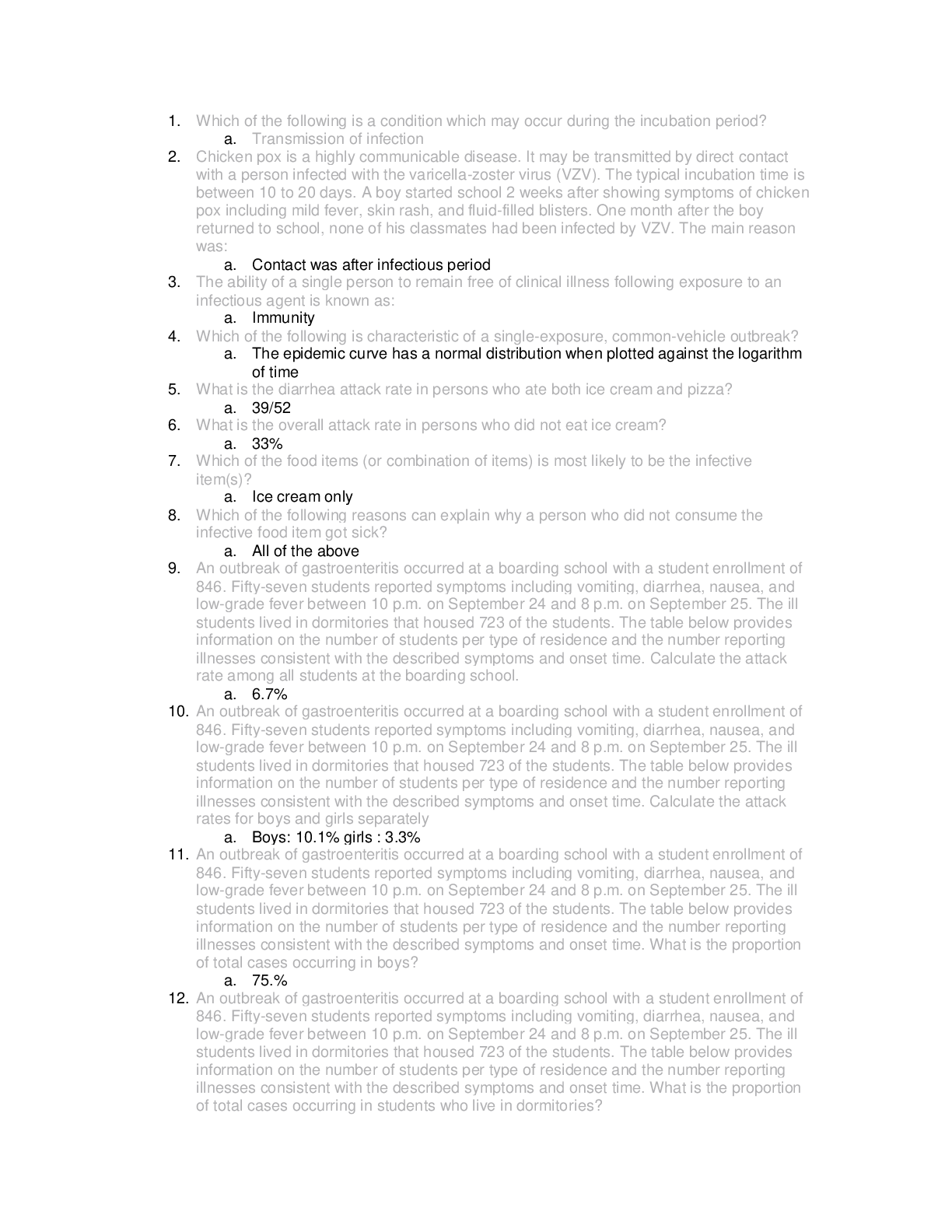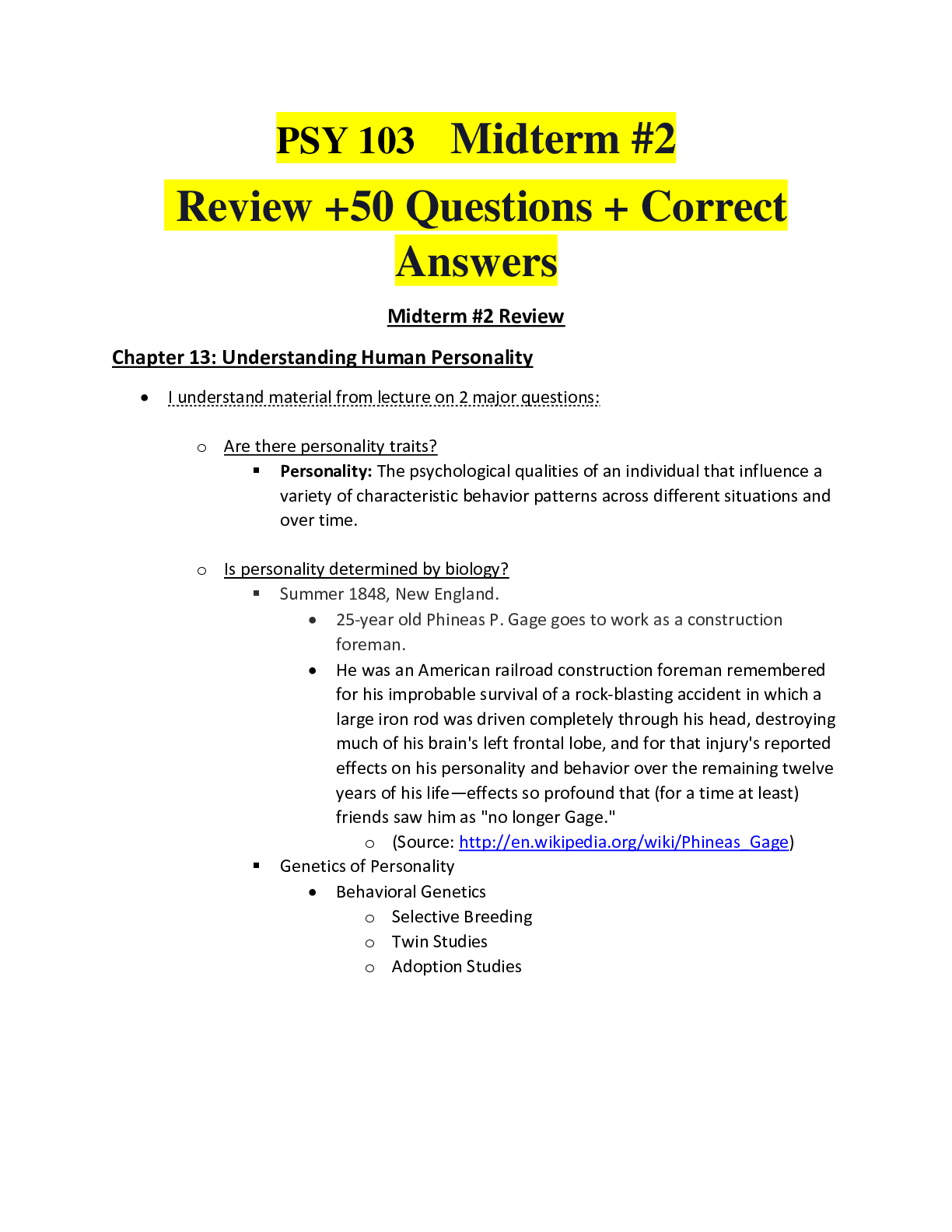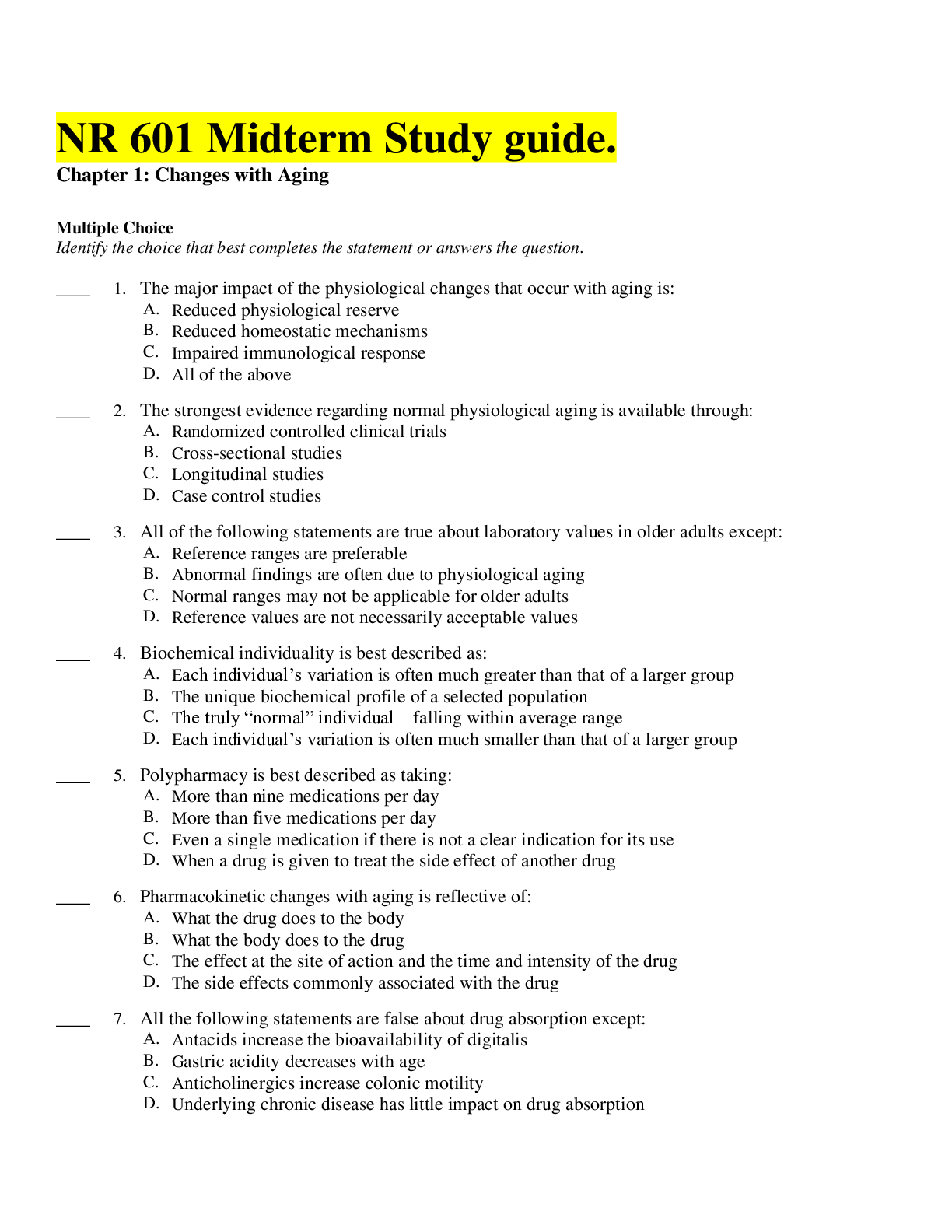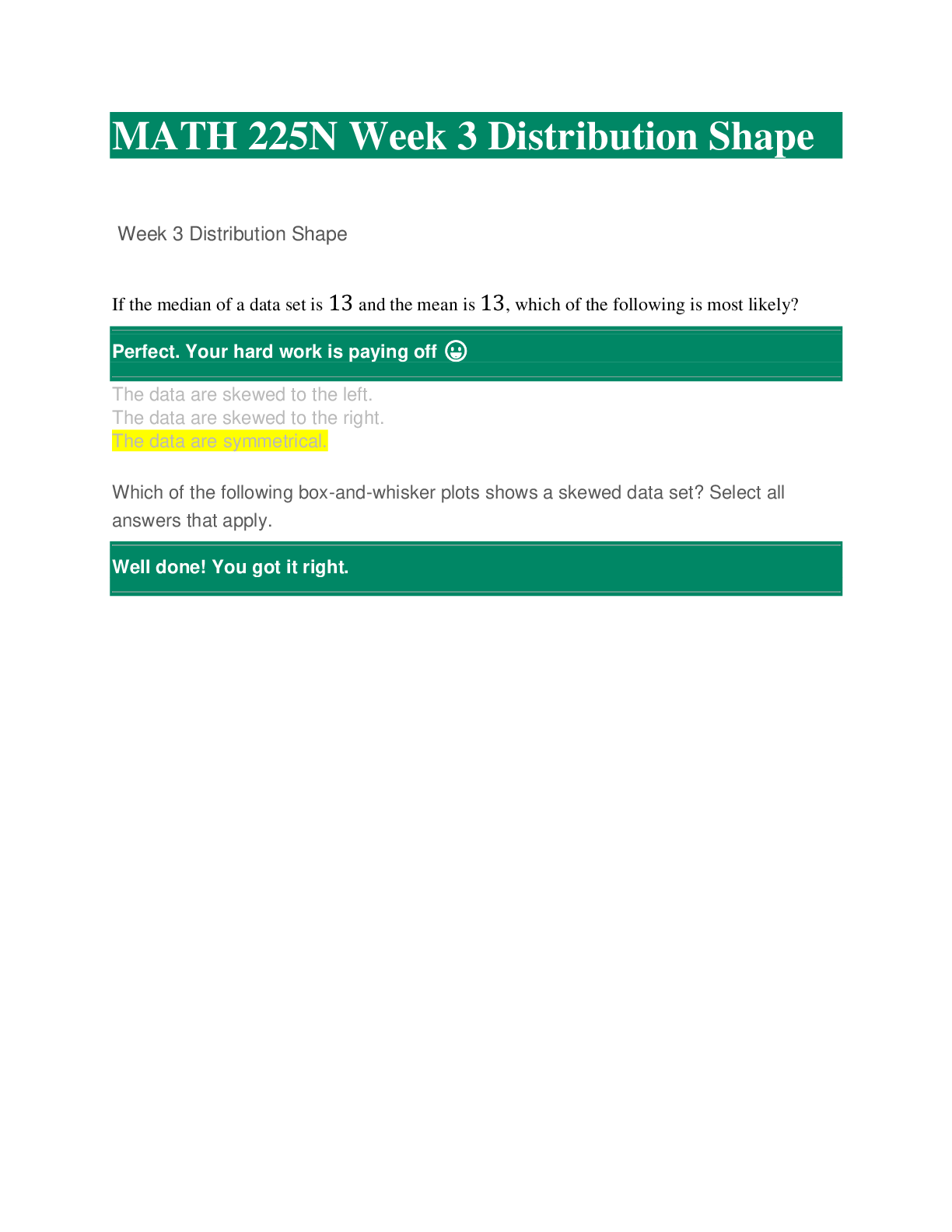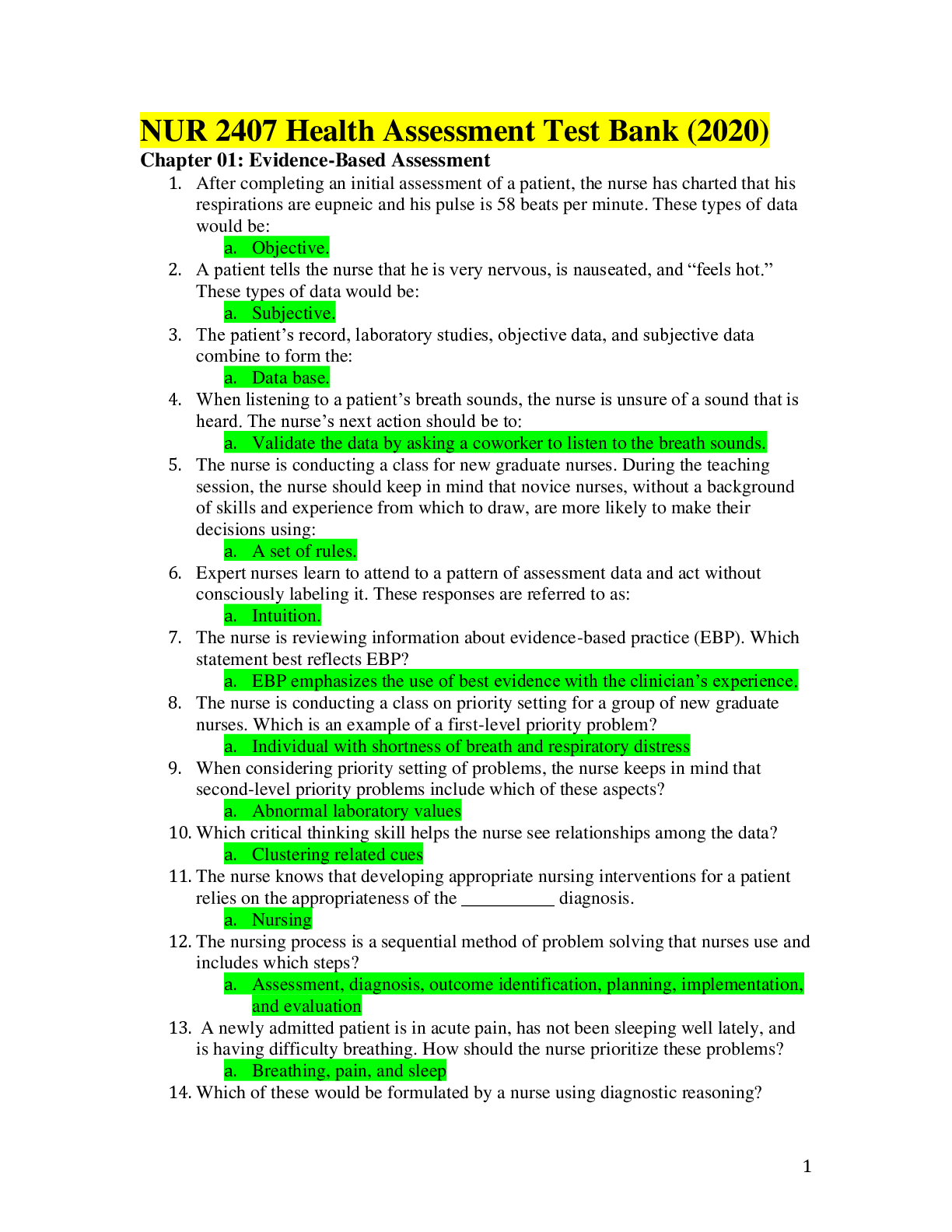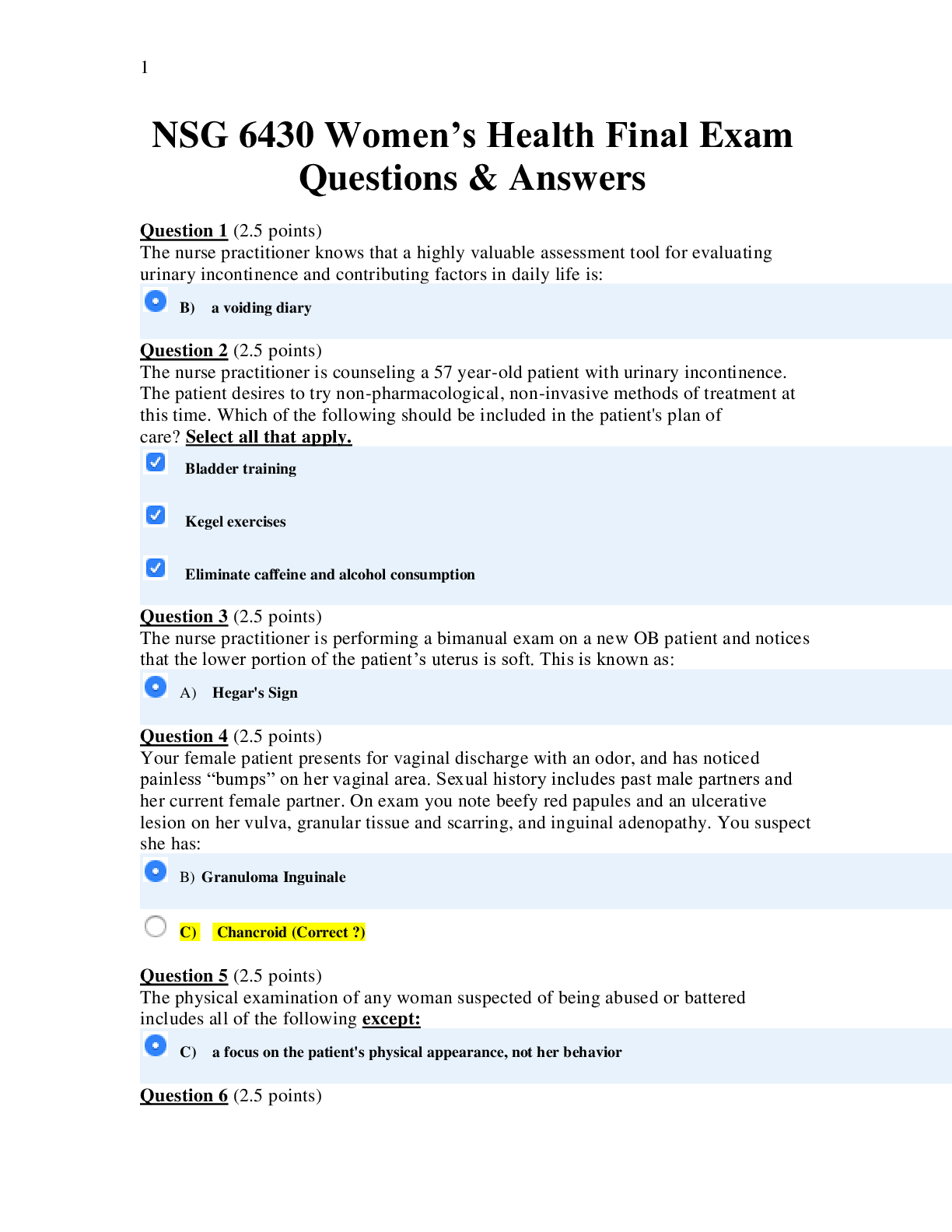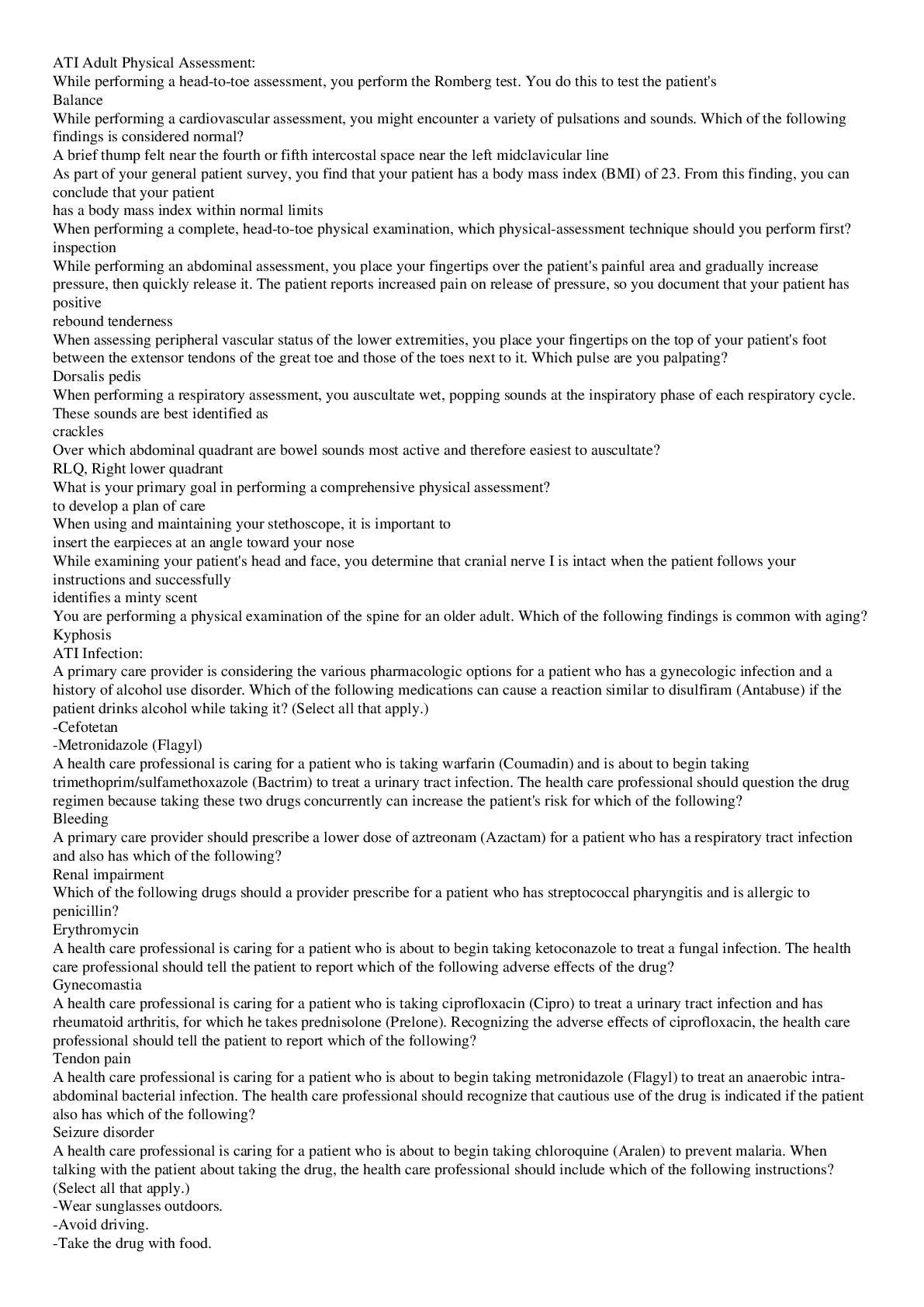Psychology > STUDY GUIDE > PSY 103 Midterm Review | Solution Guide with Questions & Answers | Fall 2025/2026. (All)
PSY 103 Midterm Review | Solution Guide with Questions & Answers | Fall 2025/2026.
Document Content and Description Below
Chapter 1: The Science of Psychology in Your Life Chapters (1, 2, 14, 15, 16) Research psychologists who take a behavioral perspective are likely to: The definition of psychology focuses on bot... h ______________ and ______________. a. behaviors; structures b. behaviors; mental processes c. mental processes; functions d. mental processes; structures 2. To what goal of psychology is “level of analysis” most relevant? a. explaining what happens b. describing what happens c. predicting what will happen d. controlling what happens 3. If you want to ______________ what will happen, you first must be able to ______________ what will happen. a. describe; explain b. describe; control c. control; predict d. explain; predict 4. While watching a horror film, Betty suppressed her emotions but Hilda did not. You would expect Betty to eat ______________ comfort food than Hilda and ______________ non-comfort food. a. more; the same amount of b. more; less c. the same amount of; more d. less; more 5. Who founded the first laboratory that was devoted to experimental psychology? a. William James b. Wilhelm Wundt c. Max Wertheimer d. John Dewey 6. A researcher tells you that her main goal is to understand mental experiences as the combination of basic components. It is most likely that she finds the historical roots of her research in a. functionalism. b. the humanist perspective. c. structuralism. d. the evolutionary perspective. 7. Who was the first woman to serve as president of the American Psychological Association? a. Margaret Washburn b. Anna Freud c. Jane Goodall d. Mary Calkins 8. Two professors at universities in Boston and Mumbai are collaborating on a research project to determine how their students in the United States and India respond to the same reasoning problems. It’s likely that they take a ______________ perspective in their research. a. humanistic b. sociocultural c. biological d. psychodynamic 9. The ______________ perspective draws on the ways in which human mental abilities serve adaptive purposes. a. cognitive b. humanistic c. evolutionary d. sociocultural 10. When you’re home with the flu, you spend a lot of time watching CourtTV. You weren’t surprised to see a ______________ psychologist testifying during a trial. a. health b. social c. forensic d. developmental 11. What type of question would a cognitive psychologist be likely to ask? a. Why do children sometimes have imaginary friends? b. Why do some students get sick every time they have a major exam? c. How can we design a keyboard for a computer that allows people to type more quickly? d. How are bilingual individuals able to switch between their two languages? 12. Which type of psychologist is least likely to focus on genetic aspects of human psychology? a. industrial–organizational psychologists b. developmental psychologists c. personality psychologists d. biological psychologists 13. Individuals with advanced degrees in psychology are most likely to be working in a. academic settings. b. hospitals and clinics. c. business and government. d. independent practice. 14. In assessments of violence risk, ______________ counts as a dynamic factor. a. gender b. substance abuse c. stability of family upbringing d. age at first conviction 15. In what phase of P4QR should you try to relate the textbook material to your prior knowledge about a topic? a. Reflect b. Recite c. Review d. Question Chapter 2: Research Made in Psychology • 1. A(n) ______________ is an organized set of concepts that explains a phenomenon or set of phenomena. a. theory b. hypothesis c. operational definition d. correlation • 2. When articles are submitted to most journals, they are sent out to experts for detailed analyses. This process is known as a. debriefing. b. informed consent. c. peer review. d. control procedures. • 3. Professor Peterson is testing the hypothesis that people will cooperate less when a lot of people are in a group. In the experiment he plans, he will vary the number of people in each group. That will be his a. placebo control. b. independent variable. c. double-blind control. d. dependent variable. • 4. Rahul is serving as a research assistant. In the first phase of the experiment, Rahul gives each participant a can of cola or a can of caffeine-free cola. In the second phase of the experiment, Rahul times the participants with a stopwatch while they play a video game. It sounds like this study is lacking a(n) a. placebo control. b. correlational design. c. operational definition. d. double-blind control. • 5. Matt is participating in a two-day experiment. On Day 1, he takes a memory test after running on a treadmill for 2 minutes. On Day 2, he takes a similar test after running for 10 minutes. The experimenters plan to compare Matt’s performance on the two tests. This sounds like a a. within-subjects design. b. double-blind control. c. between-subjects design. d. correlational design. • 6. Shirley visits an antique store. The owner explains to her that the smaller an object is, the more he can charge for it. This is an example of a a. correlation coefficient. b. negative correlation. c. positive correlation. d. placebo effect. • 7. Sally is about to travel from New York to Chicago. Although she prefers to drive, she has decided to get on an airplane. Sally reads a pair of articles about the relative safety of the two types of travel. She concludes that the one that favors air travel is considerably more valid. This sounds like an example of a. determinism. b. expectancy effects. c. informed consent. d. wishful thinking. • 8. Dr. Paul is developing a new measure of hunger. He says, “I need a measure that will accurately predict how much food people will eat in their next meal.” Dr. Paul’s statement is about the ______________ of the measure. a. operational definition b. standardization c. validity d. reliability • 9. Giovanna is worried that the results of her experiment may be affected by her participants’ desire to provide favorable impressions of themselves. It sounds as if she might be using ______________ measures. a. valid b. self-report c. reliable d. operational • 10. Ben believes that men are more likely to arrive late to classes than are women. To test this hypothesis most effectively, Ben should use a. a within-subjects design. b. a correlational design. c. self-report measures. d. naturalistic observation. • 11. Andrew wishes to test the hypothesis that people give more freely to charities when the weather is pleasant. To test this hypothesis, Andrew is likely to make use of a. double-blind controls. b. expectancy effects. c. laboratory observation. d. archival data. • 12. Before you participate in an experiment, the researcher should provide you with information about procedures, potential risks, and expected benefits. This process is called a. a risk/gain assessment. b. informed debriefing. c. informed consent. d. operational definitions. • 13. Which one of these is not among the three R’s that ethicists suggest should guide research using nonhuman animals? a. relate b. refine c. reduce d. replace • 14. Always search for ______________ explanations to the obvious ones proposed. a. optimistic b. alternative c. negative d. opposite • 15. You ask people to respond to scenarios that describe the risk associated with excess cell-phone usage. You expect people to give the highest risk estimates when they read that “______________ people suffer serious vocal chord damage.” a. 10 of every 100 b. 10 percent of c. 20 of every 100 d. 20 percent of Chapter 16: Social Psychology • 1. Grace wants to help her friend Charlie avoid the fundamental attribution error. She suggests that he focus on _______ causes of behaviors. a. situational b. dispositional c. distinctive d. consistent • 2. Which of these statements is not consistent with a self-serving bias? a. I lost because the other guy was probably cheating. b. I lost because it was too hot in the room. c. I won because I’m a genius. d. I won because I got lucky. • 3. Self-fulfilling prophecies may be modest with teachers in classrooms because a. most students perform better than their teachers expect them to perform. b. teachers usually have accurate expectations about how students will perform. c. teachers rarely have expectations about students. d. students do not allow teachers to treat them differently from their classmates. • 4. In the Stanford Prison Experiment, the guards often abused the prisoners. This result suggests that a. people seek situations in which they can indulge their aggressive impulses. b. some people are born to play the role of guards. c. only aggressive people are willing to assume the role of prison guard. d. social roles have an important influence on how people behave. • 5. Solomon Asch’s experiments on conformity demonstrate the impact of _______ in group situations. a. norm crystallization b. social rules c. normative influence d. informational influence • 6. In Milgram’s experiments on obedience, many people protested that they didn’t want to give any more shocks. After that happened, a. the experimenter told them the study was over. b. most participants asked to leave the experiment. c. most participants continued to administer shocks. d. the experimenter asked to decrease shocks. • 7. When a company hires a celebrity to endorse a product, it is likely hoping that most consumers will follow the _______ route to persuasion and engage in _______ elaboration. a. peripheral; low b. central; high c. peripheral; high d. central; low • 8. Sam chooses desserts for himself and for his friend Randy. Both desserts turn out to be duds. If Sam has a(n) _______ sense of self, you’d expect him to experience the most cognitive dissonance with respect to the dessert he chose for _______. a. independent; Randy b. interdependent; himself c. interdependent; Randy d. dependent; himself • 9. Oliver is trying to change his friend Stan’s stereotype that women aren’t as funny as men. They watch a TV special with a series of women doing comedy routines. Do you think Stan’s stereotype will change? a. Yes, because he will appreciate Oliver’s effort on his behalf. b. No, because he will discount information that is inconsistent with his stereotype. c. No, because he will convince Stan that the stereotype is true. d. Yes, because he will learn a new stereotype from the TV special. • 10. Which of these statements suggests that Carmen is exploiting similarity to get Perry to like her more? a. “Did you know that we’re both Libras?” b. “I really enjoy spending time with you.” c. “Would you like me to get you the newspaper?” d. “Your new haircut looks terrific.” • 11. Which statement is not correct? a. Companionate love is associated with life satisfaction. b. Most relationships have more passionate love at the outset. c. Companionate love is characterized by less intensity but greater intimacy. d. There is little passionate love in long-term relationships. • 12. During a job interview, Juliet subtly mimicked the interviewer’s gestures. It sounds like Juliet was trying to use _______ to improve the likelihood that she would get the job. a. norm crystallization b. the reciprocity norm c. the chameleon effect d. cognitive dissonance • 13. According to the frustration-aggression hypothesis, in which of these situations is Brett most likely to act in an aggressive fashion? a. Brett has an important job interview, but he’s stuck in a traffic jam. b. Brett’s girlfriend yelled at him all morning for being mean to her. c. Brett hates the song playing on his car radio. d. Brett thinks his boss has been monitoring the websites he visits. • 14. With respect to bystander intervention, it is typically least important that bystanders must a. notice danger in the emergency. b. label events as an emergency. c. feel responsibility in the situation. d. consider themselves to be helpful people. • 15. If you want to increase the likelihood that people will continue to volunteer in the future, which of these measures would you not want to try? a. Give T-shirts to identify people as volunteers. b. Have people start to volunteer as a mandatory assignment. c. Help people cope with distressing aspects of the volunteer work. d. Determine the motives people have for volunteering. Chapter 14: Psychological Disorders • 1. Comorbidity refers to circumstances in which an individual a. cannot be accurately diagnosed using DSM-IV-TR. b. has a neurotic disorder that cannot be easily cured. c. has a psychotic disorder that includes a fear of death. d. experiences more than one psychological disorder at the same time. • 2. Professor Hexter believes that unconscious conflicts often cause psychological disorders. Which approach to psychopathology does Professor Hexter use? a. psychodynamic b. sociocultural c. cognitive d. behavioral • 3. Analyses of legal records suggest that the use of the insanity defense is quite _______ and the probability of it succeeding is quite _______. a. rare; low b. rare; high c. common; low d. common; high • 4. For binge eating disorder, which criterion is still being researched as a potential part of the diagnosis? a. regular episodes of binge eating without purges b. a loss of control during binges c. binges causing great distress d. undue influence of body weight or shape on self-evaluation • 5. For over a year, Jane has felt anxious or worried throughout the day. It sounds as though Jane is suffering from a. panic disorder. b. generalized anxiety disorder. c. obsessive-compulsive disorder. d. agoraphobia. • 6. What attribution style puts people at risk for depression? a. internal–specific–stable b. external–specific–unstable c. internal–global–stable d. external–global–unstable • 7. When something bad happens, Chris spends a lot of time ruminating about the problem. Based on this behavior, you think it is a. more likely that Chris is a man. b. equally likely that Chris is a man or a woman. c. likely that Chris will develop a specific phobia. d. more likely that Chris is a woman. • 8. You are trying to assess the probability that Paula will develop major depressive disorder. You would be least concerned if she inherited _______ of the 5-HTTLPR serotonin gene. a. two short versions b. two long versions c. one short and one long version d. one or more short versions • 9. Nadine alternates between yelling at Tricia and begging her to remain friends. Tricia is convinced that Nadine suffers from _______ personality disorder. a. schizotypal b. narcissistic c. borderline d. obsessive-compulsive • 10. To diagnose conversion disorder, you’d try to find _______ that preceded the appearance of symptoms. a. a serious physical illness b. psychological conflict or stress c. a visit to a medical doctor d. both pain and gastrointestinal complaints • 11. Although Eve doesn’t have any organic dysfunction, she often forgets important personal experiences. This could be an instance of a. dissociative amnesia. b. hypochondriasis. c. somatization disorder. d. dependent personality disorder. • 12. Which of these is a negative symptom of schizophrenia? a. hallucinations b. incoherent language c. delusions d. social withdrawal • 13. Which of these behaviors would not generally support a diagnosis of attention-deficit hyperactivity disorder? a. Manfred blurts out answers during class activities. b. Manfred loses his toys and school assignments. c. Manfred squirms and fidgets in the classroom. d. Manfred cries when other children tease him. • 14. Professor Wyatt believes that 1-year-old Brian is at risk for autistic disorder. The professor might observe Brian to determine whether he a. fails to respond to his name. b. can walk without assistance. c. responds appropriately to loud noises. d. shows smooth pursuit with his eyes. • 15. As part of an introductory psychology class, a professor has her students interview people who have recovered from psychological disorders. This exercise should a. prompt the students to be more affected by the stigma of mental illness. b. have no impact on the students’ experience of stigma. c. prompt the students to be less affected by the stigma of mental illness. d. decrease the probability that students would seek treatment for mental illness. Chapter 15: Therapies for Psychological Disorders • 1. When Sonja begins treatment, her therapist focuses on her inner conflicts, which he believes remain unresolved. It seems that Sonja’s therapist takes a _______ approach. a. psychodynamic b. cognitive c. biological d. humanist • 2. Which of these topics would you be least likely to hear about in a lecture on deinstitutionalization? a. homelessness b. meta-analysis c. readmission rates d. violent crime • 3. In psychodynamic therapy, _______ refers to a patient’s inability or unwillingness to discuss certain topics. a. catharsis b. transference c. countertransference d. resistance • 4. Research on repressed memories suggests that a. recovered memories are never accurate. b. people’s memories are not subject to therapists’ influence. c. some memories of abuse are implanted by therapists. d. most memories are subject to repression. • 5. If Roland undergoes _______, he should expect to have a strong noxious stimulus paired with stimuli to which he is attracted. a. systematic desensitization b. behavioral rehearsal c. participant modeling d. aversion therapy • 6. Every time Janice provides a urine sample that is drug free, she gets vouchers with which she can purchase items she enjoys. This treatment is a form of a. systematic desensitization. b. contingency management. c. participant modeling. d. generalization. • 7. People can learn the process of _______ to change negative self-statements into positive coping statements. a. social learning b. self-efficacy c. cognitive restructuring d. catharsis • 8. You hear a therapist talking about how hard he works to communicate unconditional regard. You suspect that he is a _______ therapist. a. Gestalt b. client-centered c. behavioral d. psychodynamic • 9. In your introductory psychology class, you watch a movie clip of an individual in therapy addressing an empty chair as if it were his abusive boss. This clip demonstrates _______ therapy. a. Gestalt b. client-centered c. aversion d. psychodynamic • 10. The particular focus of _______ therapy will often be on poor patterns of communication. a. Gestalt b. client-centered c. couple d. psychodynamic • 11. _______ drugs largely have their impact in the brain by changing the function of the neurotransmitters serotonin and norepinephrine. a. Antidepressant b. Antianxiety c. Antipsychotic d. Antimania • 12. In clinical research, _______ proven effective at relieving the symptoms of depression. a. only ECT has b. only rTMS has c. neither ECT nor rTMS have d. both ECT and rTMS have • 13. _______ therapy is the type of treatment least likely to provide relief from major depressive disorder. a. Placebo b. Interpersonal c. Cognitive behavioral d. Drug • 14. When prevention efforts are intended to prevent relapse, it is called _______ prevention. a. primary b. regulatory c. tertiary d. secondary • 15. Because of the relative anonymity of interactions over the Internet, clients’ interactions with therapists may show _______. a. countertransference b. greater embarrassment c. confidentiality d. disinhibition Questions Exam #1 1. If someone tells you that they are a psychologist, what do you know about their day to day job? a. They diagnose and treat psychological disorders. b. They do research about human behavior. c. They learn about how the brain works. d. Psychology is a diverse profession, so it is hard to say without knowing this person’s specialty. 2. A company is looking to hire a psychologist to help improve employee morale and productivity. Which type of psychologist is specifically trained to help with this issue in the workplace? a. A clinical psychologist b. A biological psychologist c. An I-O psychologist d. A cognitive-psychologist 3. A psychologist is mostly likely to be a consultant on a court case for which of the following reasons? a. To assess the mental state of the lawyers b. To predict the behavior of the jury c. To convince the accused to plead insanity d. To testify about the accuracy of eyewitness testimony 4. You attend a talk in the psychology department, and the speaker says, “Psychological research today is largely misguided. We need to spend less time watching brains and more time watching people!” This professor likely studies psychology using what perspective? a. Humanistic perspective b. Behaviorist perspective c. Cognitive perspective d. Socio-cultural perspective 5. When psychological researchers are ready to put their hypotheses to the test, they rely on: a. intuition b. common sense c. the scientific method d. subjective judgments. 6. A researcher is interested in studying verbal aggression in adolescents. A key variable in this study is the tendency of using curse words. Which of the following is an appropriate example of an operational definition of this variable? a. The participant’s response on a questionnaire asking about cursing. b. The number of curses uttered in a 20 minute period during a lab visit. c. A report by a parent about their belief regarding their child’s cursing habits. d. All of the above are examples of operational definitions of “tendency to curse” 7. A researcher is testing the hypothesis that in order for caffeine to be most effective, a person must know that they are consuming it. Fatigued participants are randomly assigned to drink 8 oz. of regular coffee or 8 oz. of caffeine-free coffee. Half of the participants given each drink are correctly informed about the caffeine content of their beverage, the other half are misinformed (i.e. they are told the coffee is decaf when it is not, or vice versa). The type of coffee and the information about it represents what in this experiment? a. Independent variable b. Dependent variable c. Random assignment d. Standardization 8. A researcher found a positive correlation between chocolate eating and reported happiness. Which of the following would be an accurate way of describing this result? a. Eating chocolate causes people to become happier. b. Increased chocolate eating is associated with increased happiness. c. Increased happiness causes people to eat more chocolate. d. Time is related to increased levels of happiness. 9. The purpose of running a double-blind experiment is to: a. Remove experimenter bias b. Remove participant bias c. Remove experimenter and participant bias d. Study vision 10. Which of the following is an example of a naturalistic observation a. Sitting in the student center and taking notes on people’s eating habits b. Bringing people into a lab and asking them about their eating habits c. Going to the student center and asking people about their eating habits d. All of the above are examples of naturalistic observation 11. Case studies are important for the science of psychology because a. They allow researchers to publish lots of papers because they only require one subject. b. They are the only true way to study abnormality. c. They allow researchers to examine situations that would be unethical to produce in the lab. d. They generate detailed descriptions of one person or a small group of people that tend to be highly generalizable. 12. On your drive to campus this morning, someone ran a red light and cut you off. Your immediate reaction is that this person is clearly rude, inconsiderate, and a terrible driver. This type of reaction is known as: a. The self-serving bias b. The fundamental attribution error c. A self-fullfilling prophecy d. The truth 13. Even though you don’t like the color red, you wear red pants, a red shirt, and paint your face red so that you fit in with your new friends at the Stony Brook football game. What processes are most likely to be driving your conformity in this situation? a. Collegiality processes b. Informational influence processes c. Polarization processes d. Normative influence processes 14. Solomon Asch studied conformity. In his classic studies, participants had to make judgments about various things while in the presence of others. The results of his experiments suggest that: a. People are not entirely swayed by normative influence (i.e. they act independently). b. People sometimes conform, even when it seems obvious that they should not. c. Some people always conform, and others never conform. d. All of the above are supported by Asch’s work. 15. After attending social event with students from Stony Brook and Hofstra, you are asked to fill out a short survey about how much you enjoyed interacting with various people at the event. On average, Stony Brook students rated each other as more pleasant as compared to their peers from Hofstra. This is a demonstration of: a. Fundamental attribution error b. Persuasion c. Self-serving bias d. In-group/out-group bias 16. Which statement accurately describes the experience of love throughout the course of a relationship? a. All relationships always start out as passionate love and transition into compassionate love. b. Long-term relationships are rarely passionate. c. Many relationships start out with passionate love and gradually transition to compassionate love. d. If you don’t feel compassionate love in your relationship after 3 months, it is not real love. 17. Choosing not to help someone who may be in need of assistance because there happen to be other people are around who could help (i.e. a busy city street) describes what concept? a. Diffusion of responsibility b. Altruism c. Prosocial behavior d. Aggression 18. The DSM is a diagnostic system used by mental health professionals. Which of the following is NOT a primary benefit of a useful diagnostic system? a. It provides a common shorthand language. b. It contributes to an understanding of causality. c. It provides a helpful structure for treatment planning. d. It accurately labels people, resulting in stigmatization. 19. A person is diagnosed with both Major Depression Disorder and General Anxiety Disorder. This is an example of what phenomenon? a. Double disorder b. Comorbidity c. Axis co-diagnosing d. Agoraphobia 20. Which of the following is NOT a central understanding of the sociocultural perspective on psychopathology? a. The threshold at which a behavior is considered problematic will depend in part on cultural context. b. Behaviors may be interpreted in different ways in different cultures. c. Cultural circumstances may bring about distinctive types or subtypes of psychopathology. d. Certain cultures will never experience certain disorders. 21. When diagnosing a client with panic disorder, the therapist must specify if agoraphobia is or is not present. What is agoraphobia? a. A phobic fear of spiders b. An extreme fear of being in public places or open spaces c. An example of flashbacks in post-traumatic stress disorder (PTSD) d. A synonym for the manic phase in bipolar disorder 22. Which of the following are NOT criteria used to label abnormal behavior? a. Elevated laboratory tests b. Distress or disability c. Maladaptiveness d. Statistical rarity 23. Mary is very fearful she will act in an embarrassing way at an upcoming party. What disorder does Mary most likely have? a. Antisocial personality disorder b. Social phobia c. Major depressive disorder d. OCD 24. PTSD (post traumatic stress disorder) is a consequence of traumatic events. What is one symptom people with PTSD commonly experience? a. Catatonia (subtypes of schizophrenia) b. Compulsions (OCD) c. Trichotillomania (picking hair obsessively, not something you need to know) d. Flashbacks 25. When trying to identify the cause of a person’s depression, a behavioral psychologist would most likely focus on: a. Negative cognitive sets, or patterns of perceiving the world b. The effects of the amount of positive reinforcement and punishments a person receives c. Unconscious conflicts and hostile feelings (psychodynamic) d. Levels of chemical messengers in the brain (pharmacological, biomedical) 26. Rachel believes she has germs on her hands and experiences intense urges to wash her them. She begins to do so in a ritualistic fashion. In this scenario, the urge to wash is a(n) _________ and the act of washing is a _________. a. Obsession, compulsion (compulsion is what a person does to alleviate an obsession – the urge) b. Compulsion, obsession c. Phobia, compulsion d. Compulsion, stress disorder 27. Some cognitive psychologists theorize that the gender difference in depression is due to ___________, a tendency to focus obsessively on problems. a. Hypochondriasis b. Rumination c. Delusional thinking d. Disordered mood 28. Ahmed becomes convinced that his stomachaches prove he has a tumor growing in his stomach, even though doctors have said he is fine. Ahmed may suffer from: a. Catatonia, a subtype of schizophrenia b. Hypochondriasis , a somatoform disorder (since doctors can’t diagnose, you know it would be relating to this answer) c. Medical phobia, an anxiety disorder (tempting, but not defined specifically) d. Autism, a developmental disorder 29. Which of the following is an example of the consequences of stigma due to mental illness? a. Lucy receives disability payments due to her depression b. Michael’s family find out about his eating disorder and attend family therapy with him c. Larry loses his job after his employer learned he was hospitalized for bipolar disorder d. Mariah has trouble holding a job because she has schizophrenia 30. There are four primary goals in the therapeutic process. The first three are: 1. Reaching a diagnosis 2. Proposing a probable etiology 3. Making a prognosis of course of problem with and without treatment What is the fourth goal? a. Discovering the cause of the disorder b. Prescribing and carrying out treatment c. Institutionalization d. Analysis of unconscious inner conflicts 31. Dimitri’s therapist helps him gain insight into the unresolved conflicts across his lifetime that may have caused his negative symptoms. His therapist is using which of the following approaches to therapy? a. Psychodynamic b. Cognitive c. Behavioral d. Humanistic 32. Deinstitutionalization is the recent shift to treat mental health issues outside of inpatient hospital settings. What is one of the unexpected consequences of deinstitutionalization? a. Slower recovery rates b. Higher incidence of mental illness in women c. More people with mental illness becoming homeless d. Higher rates of hospitalization in children 33. In psychoanalysis, the therapeutic approach developed by Sigmund Freud, the primary procedure used to probe the unconscious and release repressed information is: a. Free association (specifically the approach used to probe the unconscious) b. Participant modeling c. Dream analysis d. Contingency management 34. A psychoanalyst is concerned about her negative feelings toward a client. The client reminds her of her father, with whom she had a bad relationship in childhood. In psychoanalysis, this phenomenon is called: a. Transference b. Countertransference (this example is talking about the person giving the therapy) c. Free association d. Counterconditioning 35. The central therapeutic principle in exposure therapy is that exposure permits: a. Deinstitutionalization b. Generalization c. Transference d. Counterconditioning 36. Exposure therapies have proved to be highly effective for treating _______ disorders. a. Anxiety b. Mood c. Personality d. Schizophrenia 37. ______ therapists focus on teaching clients to see the “shoulds” and “musts” that are controlling their lives and preventing them from living how they would like. a. Cognitive behavioral therapist b. Rational emotive (emotions are associated with these shoulds and musts) c. Counterconditioning d. Pastoral 38. What type of therapy seeks to establish an atmosphere of unconditional positive regard, or nonjudgmental acceptance and respect for the client? a. Behavioral b. Biomedical c. Client-centered (example explains fundamental aspects of client centered therapy) d. Psychodynamic 39. What do SSRIs, a type of medication often prescribed for depression, do in the brain? a. Reduce the slower electrical waves in the brain, known as alpha waves b. Increase electrical activity in the cerebellum c. Reduce the reuptake of the chemical messenger serotonin d. Shut down the dopaminergic system 40. Which of the following is NOT true of electroconvulsive therapy (ECT)? a. It has proven generally successful at reducing symptoms of depression b. It produces side effects, such as amnesia and temporary disorientation c. It is used as a first line of treatment for depression d. It consists of applying weak electrical current to the scalp until a seizure occurs 41. What is an example of an important “common factor” that is present in successful therapies? a. Pharmacological treatments b. A relationship of trust, warmth, and acceptance between the client and the therapist c. Operant conditioning techniques d. Laboratory tests, such as blood draws, to identify initial problems 42. A _______ approach to treating a client would be to help him or her become more self-actualized, while a _______ approach would be to focus on changing the physiological aspects of mental illness through, for example, medication. a. Cognitive, depressive b. Psychodynamic, trauma-focused c. CBT (Cognitive behavior therapy), pharmacological [Show More]
Last updated: 6 months ago
Preview 1 out of 55 pages

Loading document previews ...
Buy this document to get the full access instantly
Instant Download Access after purchase
Buy NowInstant download
We Accept:

Reviews( 0 )
$10.50
Can't find what you want? Try our AI powered Search
Document information
Connected school, study & course
About the document
Uploaded On
Oct 13, 2019
Number of pages
55
Written in
Additional information
This document has been written for:
Uploaded
Oct 13, 2019
Downloads
0
Views
272

